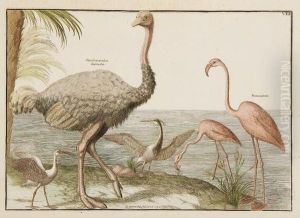Jan Jonston Paintings
Jan Jonston, also known as Johannes Jonstonus or Jan Jonstonius, was a Polish scholar and physician of Scottish descent. Born on September 15, 1603, in Szamotuły, then part of the Polish-Lithuanian Commonwealth, he was a polymath with interests ranging from natural history to linguistics. Although not primarily known as an artist, Jonston's legacy includes a significant contribution to the world of natural history illustration, particularly through his encyclopedic work 'Historiae naturalis de quadrupedibus libri,' which contained numerous engravings of animals.
Jonston's family was of Scottish heritage, and he received a comprehensive education. He studied at the universities of St. Andrews, Cambridge, and Leiden, showing early on a profound interest in a wide array of subjects. He became well-versed in medicine, theology, and natural sciences, among others. After completing his studies, Jonston practiced as a physician and became a respected intellectual figure of his time.
His natural history works, which were heavily illustrated, were especially notable for their detail and breadth. Jonston's approach to the compilation of knowledge in his books was encyclopedic, and he sought to bring together the sum of contemporary understanding of the natural world. His books on birds, fish, insects, and snakes, as well as quadrupeds, were all published in the 17th century and were widely recognized for their comprehensive nature and the quality of their illustrations, which were often based on specimens and earlier texts rather than direct observation.
Jan Jonston passed away on June 8, 1675, in Legnica, Poland. His works continued to be influential after his death, serving as reference material for scholars and naturalists. The illustrations from his books were reproduced in various forms and continued to contribute to the fields of biology and zoology. Despite being less known as an individual artist, Jonston's role in the history of scientific illustration is significant, and his contributions to the visual documentation of natural history remain his enduring legacy.
